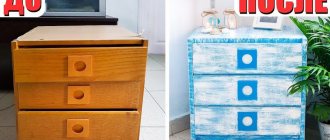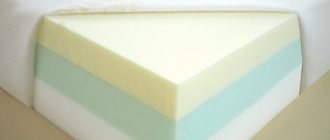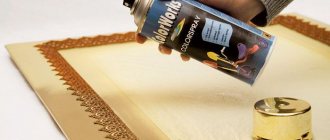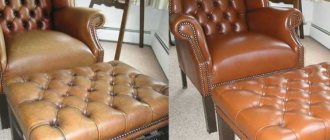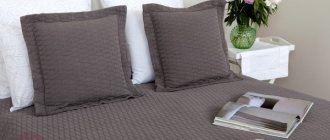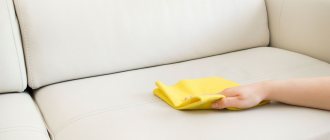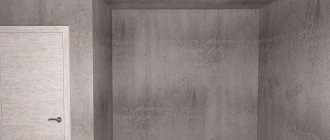0
62464
Beautiful, functional furniture is a must-have attribute of a home, office or apartment. Cabinet products in furniture production are decorated with facades treated with film material. A coating such as PVC film for furniture facades protects elements from moisture, scratches, damage and has an important decorative function. The coating allows you to implement many interesting ideas and design projects.
Features of obtaining laminated chipboard
Chipboard (chipboard) is used for the manufacture of furniture in the “medium” and “economy” classes. If the surface is covered with a decorative and protective material, then we are talking about laminated chipboard (LDSP).
For cladding laminated chipboards the following is used:
- The plastic is laminated paper, impregnated with a resin composition.
- Paper film impregnated with synthetic thermosetting resins.
When producing chipboard in a factory, a conveyor or short-cycle belt press is used. Under conditions of high pressure and temperature, the resin spreads over the surface and forms a durable, solid web.
Important! Modern equipment used in enterprises makes it possible to achieve a realistic imitation of the texture of wood, textiles, and ornamental stone. Laminated chipboard is produced with a glossy, embossed surface, as well as with a 3D effect.
Alternative technologies:
- Another technology for decorating chipboard is often confused with the lamination process: lamination. In classic lamination, the resin is melted and then pressed. Laminating involves gluing. An adhesive is applied to the base, then a polymer thermoplastic film or laminated paper is applied.
Important! This material is less durable and can swell and deform. As for the laminated board, it is a single inseparable whole.
- There is another technology reminiscent of lamination - veneering. Veneer is the thinnest layer of noble wood. The veneer thickness is from 2 mm. Gluing to the veneer surface is carried out using adhesive compounds: one- or two-component.
Important! The surface doesn't just look beautiful. It is truly unique, since the natural grain of the wood is preserved. Veneer is quite demanding to maintain. It can be painted, varnished, impregnated or waxed. If the coating comes off, experts recommend using universal or carpenter's adhesive.
- Sometimes you can find such a definition as synthetic veneer. This is a paper canvas with a texture that imitates the unevenness of wood, impregnated with urea resin. Sometimes the surface is varnished.
Important! The material is durable, hard, and feels identical to wood veneer.
Lamination, therefore, is a technology of “welding” decorated paper to a base using synthetic molten resins. The resulting surface is resistant to high temperatures, moisture and mechanical stress.
What is chipboard? Features of the technology
Cabinets, cabinets, kitchen sets of middle and economy classes are made from chipboards that have undergone the stage of surface lamination with decorative and protective materials at the factory. These are the so-called chipboards.
The variety of colors and textures of laminated chipboard is amazing
Cladding is one of the final stages of chipboard manufacturing. This uses:
- paper film impregnated with thermosetting synthetic resins;
- laminated paper plastic containing impregnating resin compositions.
For the production of laminated chipboards, short-cycle or conveyor belt presses are used. At temperatures up to 250°C and under the influence of a pressure of 25-30 MPa (25-30 kg/cm 2 ), a physical and chemical process occurs: the resin seems to spread over the surface, seals it and forms a durable single canvas.
The production capacities of large factories make it possible to achieve a complete imitation of the texture of wood, stone, fabric, etc. Often, for individual collections of furniture or decorative finishing works, slabs with gloss, embossing, varnished or with a 3D effect are produced.
Lamination is often understood as another process - lamination. The technologies are similar, the difference is in the fastening composition. If in the first case synthetic resins are first melted and then pressed, then in the second case gluing is used. An adhesive composition is applied to the base plate, then a thermoplastic polymer film or hardened laminate is applied and rolled. This type of coating is weaker to tear off and can swell and get wet. A laminated board is actually a single whole and practically cannot be divided into components.
The next process, similar to lamination, is veneering. Veneer is a thin section of valuable wood with a thickness of at least 2 mm. Glued with special one- or two-component adhesive compounds, the surface turns out beautiful and unique, since there are no two identical layers of wood, and it is this fact that adds attractiveness and beauty to the veneer. The coating requires care and protection from moisture and mechanical damage. HDSP can be painted, varnished, waxed, oiled or impregnated. When peeling off elements, it is recommended to use carpentry or universal adhesives.
Marketers have coined a new term - synthetic veneer. A sheet of textured paper with a decor that imitates wood pores is impregnated with urea resins and dried. Often the surface is varnished. The resulting material is called synthetic veneer, and is glued to the surface of the chipboard under pressure and at high temperature. The coating turns out to be quite hard, dense, identical to natural veneer even to the touch.
Thus, lamination is the process of “welding” paper with decor using a melt of synthetic resins. This is the most reliable and durable method of cladding chipboard. The surface is durable, resistant to elevated temperatures and water, and mechanical damage.
Do-it-yourself methods for laminating chipboard
Of course, it is impossible to accurately reproduce the factory process of chipboard lamination with your own hands. If only because you have neither professional skills nor specialized equipment. In addition, the compositions used for industrial lamination contain toxic substances.
The best option is laminating:
- Chipboard cladding using self-adhesive film. This is a dense canvas made of synthetic material with an adhesive applied to the reverse side.
Important! It is enough to remove the layer of protective paper and glue the film to the surface. Air bubbles can be removed with a plastic spatula or soft cloth.
- Gluing a film of polymer material using universal glue. The glue is applied to the chipboard and left for a short time. Then the film is carefully glued. For better adhesion, it is rolled with a roller or pressed with a press.
Important! Of the two options given, the second one is more reliable. As practice shows, self-adhesive tape has to be re-glued periodically or a new one must be purchased. The savings are quite dubious. The best option is to purchase chipboard with industrial lamination.
How are chipboards made?
To make laminated chipboards, ordinary sanded chipboards are used, so they are produced at a chipboard production plant, connecting a lamination section .
Moreover, 3 technologies are used to cover the source material with a laminating film:
- lamination;
- laminating;
- smooth lamination.
Lamination
When laminating, 1-2 layers of specially prepared paper are glued onto the base , and the first layer - the base - is made as thick as possible so that the design can be pressed into it.
The thickness of the base, depending on the depth of the pattern, can reach 0.5–1 mm, the thickness of the second layer is tenths or even hundredths of a mm.
On top of these layers, another one is laid, made of transparent paper and a mixture of various resins, which, when heated, turn into a durable film that reliably protects the decorative surface.
The base layer is laid on the prepared chipboard surface and pressed down with a hot stamp with a suitable pattern.
The surface temperature of the stamp is 150–220 degrees, due to which the resin that impregnates the base layer is mixed with the resin that glues the chips in the chipboard and the paper becomes an inseparable part of the board .
Then, in the same way, a decorative layer with a suitable pattern and an outer layer are glued, which protects the slab from damage.
At some enterprises, all layers of coating are first connected to each other, then dried and, only after that, attached to the chipboard.
With this technology, the coating is made in the form of a tape. The pattern on it is formed using a cylinder with an installed matrix, similar to the formation of a pattern during laminating.
The difference with laminating is that the tape is attached without glue, heating the resins that impregnate the paper until it melts and mixes with the resin in the chipboard.
Laminating
When laminating, the facing material is first prepared, for which all layers are laid in order and a pattern is printed on them using a cold press .
At the same time, the uncured resin of the various layers is mixed, due to which the coating turns into a wide and long ribbon.
If a cylindrical stamp , then it becomes possible to make ribbons of any length .
Many small enterprises producing laminate with a three-dimensional texture prefer not to spend money on expensive equipment necessary for the production of tape, but to buy ready-made material.
The finished tape is sent to the dryer, then wound into rolls, which are delivered to the laminating area. There, the facing material is cut to size and placed on a slab coated with a special glue, then pressed with a press and heated until the glue is completely polymerized.
Thanks to this technology cladding goes faster , because there is no need to heat each layer of coating separately , so the enterprise can produce more products.
The disadvantage of this technology is that the glued cladding holds much weaker than real lamination.
Smooth lamination
This technology is similar to laminating , but is a full-fledged lamination, because when heated, the resin of the coating and the boards are mixed, forming a single material. In addition, there is no press for creating a pattern .
To create a smooth surface, it is enough to lay 2 layers, the bottom of which will be made of paper , and the top of a special film, which, when heated, forms a durable and transparent coating .
Due to the fact that large chipboard manufacturers are constantly looking for ways to increase production manufacturability and reduce costs, various changes are constantly being made to this process, the essence of which is kept secret by manufacturers. After all, any improvement in the quality of the laminating coating, as well as a reduction in costs, makes their products more competitive.
How to laminate chipboard at home: laminating technology
This part of the article is dedicated to stubborn people who are used to doing everything on their own. So, the procedure for gluing a chipboard board with a synthetic film is as follows:
- Cleaning and puttying the slab. The result is an absolutely smooth and even surface.
- Surface primer with any wood composition.
- Open the films. For this you will need: scissors, a pencil and a tape measure. You can get a perfectly smooth edge using a utility knife and a guide.
Important! The centimeter grid on the back of the film makes cutting more convenient.
- Separating the film from the protective base and gluing it to the surface of the chipboard.
Important! To make the film lie evenly, you need to smooth it with a clean, dry cloth from the center to the edges. If you blow the film with a regular hair dryer (in this case you will need an assistant), it will lie more evenly.
Which film to choose for lamination?
In factory conditions, chipboard lamination is carried out using:
- laminated paper impregnated with resins;
- impregnated papers made from similar materials.
When using resin impregnation, the paper can be given moisture-repellent properties, and a thick layer of material allows for embossing that imitates the texture of valuable wood or stone.
Both natural veneer and thermoplastic synthetic films are used as coating. In each case, the chipboard processing technology is slightly different, but in everyday life all materials with a moisture-resistant coating are called laminated.
When choosing ready-made slabs for making furniture, you should inquire about the gluing method:
- laminated chipboard does not differ in appearance from laminate, but has less coating strength;
- veneered products always have a natural wood pattern; you can consider individual coating plates;
- covered with synthetic veneer (film) differ from natural ones in their low price and the absence of strips of wooden cladding in the design.
Often, when making furniture on their own, craftsmen try to laminate chipboard at home to save money. Due to the complexity of the industrial process, it is not possible to reproduce it, and chipboard cladding is carried out with different types of synthetic film.
There are several types of coating suitable for installation at home:
- Melamine film. The material contains phenol-formaldehyde resins, which are hazardous to health when heated. Laminating furniture at home should be done with good ventilation. After cooling, the material becomes safe and forms a thick and durable layer with moisture-repellent properties on plywood or chipboard. Melamine is most often used for edge finishing.
- PVC. PVC membranes may have an adhesive layer, but are sometimes produced without it. In the latter case, you can glue the laminate onto the chipboard using universal adhesives. It is better to choose them immediately when purchasing the material. Treating particle boards with self-adhesive is the easiest way to apply a waterproof and decorative coating.
- Phenolic film. It is not highly moisture resistant, but it protects surfaces well from mechanical stress.
Having chosen the right material, you can laminate chipboard yourself without special equipment.
Selecting lamination film
The film that is used when laminating chipboard with your own hands is divided into the following categories:
- Melamine. Gives the material additional resistance to moisture and mechanical stress. Melamine film contains formaldehyde resin, which poses a health hazard.
- PVC. Polymer material that does not contain toxic substances. This significantly improves the water resistance of the base. PVC film is excellent for interior finishing work.
- Phenolic film. Compared to the two previous options, it is not very moisture resistant, but it significantly increases the wear resistance of materials.
Lamination and lamination of chipboard. Chipboard technology.
Chipboard lamination and lamination technology.
Production of laminated chipboard. Decorative coating for furniture boards. To use chipboard in furniture production, sanded chipboard is subjected to decorative processing - a decorative coating of laminated paper (melamine) films is applied. At this production site, sanded chipboard is converted into laminated chipboard. The production of laminated chipboards is the process of lining sanded chipboards with paper-based films (laminated paper films).
There are two methods for decorative processing of chipboards with paper-laminated films:
- Chipboard lamination.
- Chipboard lamination.
The main difference between lamination and lamination of chipboards is that during lamination, a decorative coating is created by chemical pressing and is a component of the board, while during lamination, a ready-made solid paper-resin film is glued to the board.
We repaint laminated furniture with our own hands - stages of work
Stage 1 - Preparatory
The laminated surface of any furniture is plastic (polyvinyl chloride, PVC), resistant to water. If you paint such a smooth surface, the paint will not stick, even the most expensive and high-quality one. Therefore, the surface must be carefully prepared. First, you should remove all fat from the surface using special solvents and detergents.
To make work more convenient, it is better to disassemble the furniture. But if you only need to repaint the facades, then you can remove only them from their hinges and lay them on a horizontal surface. If the fittings are not removed during painting, then it makes sense to protect them with masking tape.
Stage 2 - Sanding the surface
To prevent the paint from falling off after application, the top layer must be removed from the laminated surface. Sandpaper is suitable for this. First, you should use a coarser-grain sandpaper to remove the laminating layer, and then sand the furniture with a fine-grain sandpaper. This treatment will create a rough surface on which the paint will adhere better.
Do not forget to use personal respiratory protection when working, as dust from plastic is quite harmful.
Stage 3 - Sealing cracks
To seal cracks and chips, you need to use either a special composition based on epoxy resin or putty (preferably latex). Before treating cracks, they must be primed and allowed to dry. Then the cracks are sealed and the composition is also allowed to dry completely. A small spatula is used as a tool.
Stage 4 - Surface priming
Priming is a mandatory step before painting. A good quality primer will prevent the paint from peeling and bubbling. Give preference to a polyurethane-based primer; this composition sticks to everything, even glass and ceramic tiles.
If such a composition is not available, then you can purchase a primer in cans intended for painting a car. But when working in it, the presence of a respirator becomes a prerequisite. The soil must dry for at least 12 hours.
If you plan to paint the furniture in a specific color, then the primer can also be tinted in the selected shade to create some kind of “background”.
Stage 5 - Painting
Which paint to choose for laminated furniture? This is the first question that craftsmen ask before painting. Of course, it is better to give preference to special paints marked “for furniture,” but alkyd or polyurethane paints are also an excellent solution. But epoxy-based paints, although they give excellent results, take a long time to dry and stink. You can use such paints only if painting takes place somewhere in a garage or shed.
Chalk paint would be an excellent solution, especially since you can make it yourself.
To paint furniture made of laminated chipboard, you can also choose acrylic paints, but in this case you will have to prime it at least twice beforehand.
As a tool, choose a short-pile velor roller - such rollers paint much better than foam rollers and create an even layer. For hard-to-reach places, such as corners, choose brushes of different sizes (you’ll have to check which one is convenient for you - you’ll have to check it in practice).
So, you will have to paint in two layers, allowing the first layer to dry thoroughly. If suddenly for some reason something cannot be painted over, then this place can be decorated, for example, using the decoupage technique.
Stage 6 - Protection
If repainted furniture is exposed to active moisture or wear (for example, kitchen facades or furniture in the hallway), then applying varnish over the paint would be an appropriate solution. Choose acrylic varnish; both glossy and matte varnishes are available. The varnish is applied either with a brush or a roller to completely dry paint.
So, painting laminated furniture with your own hands is not difficult, especially if you know all the nuances. And after proper preparation, you will actually end up with new furniture, perhaps even better than the old one. And, what can I say, this will still help you save on buying new furniture and get a truly exclusive item.
Types and uses of laminated MDF - Finishing
Surely everyone has heard about such a thing as decorative processing of materials. One of these types is laminated MDF. Currently, it is often used in many areas of production, for example, in the manufacture of doors, furniture, etc.
What is lamination? This is a type of decorative processing of slabs. It is intended to decorate the product, and also helps to improve the technical and operational properties of the material. Laminated MDF panel has deservedly taken a leading position among other building materials.
Laminated MDF: general concept
MDF boards are more modern and high-tech products compared to their predecessors. In their manufacturing process, only modernized technologies are now used. The basis of such material is wood processing waste. As well as non-commercial wood, which due to its low quality is not suitable for high-quality products.
The appearance of this material allows you to significantly refine the products, giving them luxury and richness. A striking example of this are laminated MDF doors.
Manufacturing technology of laminated MDF
The MDF production process is as follows. Special chipping machines grind all raw materials into chips.
Next, the resulting mass is doused with hot steam under high pressure, which makes the material much softer. After this, the workpieces are brought to a certain consistency.
During this process, lingin (a natural binding substance) is released from the wood fibers. The last stage is drying, pressing and gluing.
In order for the finished product to become laminated, its front surface is subjected to additional processing. Why is this process necessary? Lamination is performed in order to give the material additional properties, that is, to make it as resistant to moisture and various types of wear as possible.
Pursuing this goal, a paper-resin or melamine film, which contains a special astringent composition, can be applied to the sheet. After this, the MDF is subjected to heat treatment. Such technological influence leads to certain chemical reactions. Thanks to them, the composition located on the surface films impregnates the sheet.
When polymerization of the resin begins, which forms the surface layer (it does not separate from the finished product), laminated MDF is obtained.
As for the technical characteristics of this material, thanks to modern technology it is extremely resistant to high humidity and the effects of various chemicals. It is the laminated layer that prevents the growth of any kind of fungus or mold.
Advantages and disadvantages of MDF
It is clear that each material has its pros and cons. Laminated MDF is no exception. Among its main advantages, it is worth highlighting its hygiene, reasonable cost, especially in comparison with natural wood, and environmental friendliness.
In addition, this material has high sound and heat insulation properties. A wide range of color solutions allows you to implement different design ideas.
And finally, the most important advantage is simple assembly; installing laminated MDF is quite easy, you don’t need to have any special skills for this.
As for the downsides, there are few of them. The low level of fire resistance and the relatively large weight of the slabs deserve special attention. This may pose some restrictions on the use of this material. It is also worth noting that when exposed to high temperatures, the top layer of MDF peels off.
Cost of laminated MDF panels
Despite the fact that laminated MDF has excellent mechanical and performance characteristics, its price is not that high when compared with other natural wood products.
The special process of MDF production, during which it is customary to use non-profitable wood (with a low input price) or wood waste, has a significant impact on the formation of costs.
This material differs in thickness and size, which, in turn, are displayed in monetary terms.
Laminated MDF (price starts from 300 rubles and above) can be purchased at any specialized store.
Source:
Laminated MDF (LMDF boards)
» New trends in finishing » Laminated MDF (LMDF boards)
Brief characteristics of MDF
Medium Density Fiberboard, or MDF, is a board made from fine-grained shavings of industrial wood.
The raw materials are ground practically into dust, mixed with polymer resins and put into a special heat-pressing unit.
The resulting material is similar in some respects to fiberboard, but unlike the latter, it has better characteristics in terms of basic indicators:
- Slab density – 400-750 kg/m3;
- Bending strength – up to 23 MPa;
- Modulus of elasticity during static bending – up to 1700 MPa;
- The level of formaldehyde release is E0-E1 (up to 10 mg per 100 g of dry matter);
- Humidity – no more than 10% of weight.
Mechanically, MDF is much stronger and easier to work with. This is the only material among its analogues, the surface of which can be processed with a milling cutter, cut out shaped elements and form bent parts. Such operations are impossible with either chipboard or OSB.
In addition, MDF has the following set of advantages:
- Long service life.
- Low level of thermal conductivity.
- Possibility of using various types of processing and finishing (painting, varnishing, laminating, postforming and much more)
- Moisture resistance (not to be confused with water resistance).
- Hygiene.
- Low price.
Since the products, in the language of designers, are very plastic and easy to process, the lamination technique is widely used for surface finishing. Plastic film or paper impregnated with melamine resins is glued to the front side. The resulting sheets are called “laminated MDF” (LMDF).
“Semi-finished” slabs are produced in a wide range of sizes:
- Length - up to 6 m;
- Width – from 0.1 to 3.75 m;
- Thickness – 3-40 mm.
Features of LMFD
MDF boards undergo a lamination process not only to protect the surface from scratches, water and other negative factors. the purpose is decorative. Modern high-precision laser printing technologies make it possible to create any image with a perfectly executed depiction of any small detail. For example, this could be the texture of wood, the pores of brick, etc.
We recommend: Glass tiles for interior walls and floors
All this allows you to get a pattern on the MDF surface that imitates the color and structure of natural wood, natural stone, porcelain stoneware or tiles, textiles, leather, metal and much more. Various effects and techniques are used: aging, matting, patination, rustication, brushing, etching, etc.
Each manufacturer (Kronostar, Kronospan, Egger, KZMDF, etc.) develops its own line of designs, including:
- traditional wood decors (beech, oak, cherry, walnut);
- certain exotic wood species (jatoba, zebrawood, kempas, panga-panga);
- imitation stone surface (tiles, marble, limestone, granite, concrete);
- monochrome pastel, less often bright colors (vanilla, orange, saffron);
- metallized decors;
- non-standard (abstract combinations of shades, geometric shapes, thematic designs).
Thus, LMDF has a presentable appearance and a leading number of decors. Every year the range is replenished with new designs.
The sheets are quite durable, but, nevertheless, they must be properly transported and protected from atmospheric phenomena (precipitation, wind, direct sunlight) and mechanical damage. Storage and operation of products is carried out at an average temperature of +15 to +25 ° C and a relative air humidity of no more than 70%.
Other methods of processing furniture
In addition to simply applying film to glue or gluing self-adhesive tape, there are several other methods for processing chipboard furniture:
- — Laminating. In this method, glue is applied to the product, and then a thermal film of a polymer composition is applied.
- — Veneering. Veneer is a very thin layer of high-quality wood, if natural, if synthetic - paper canvas with imitation of wood patterns. Using molten resins, such material is welded to the base under the influence of high temperatures.
Thus, laminating furniture at home is quite easy and the quality depends solely on your efforts.


